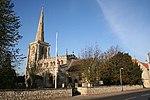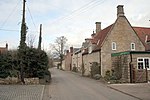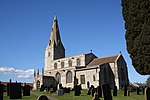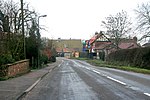St Bartholomew's Church, Welby
Church of England church buildings in LincolnshireEnglish Gothic architecture in LincolnshireGrade I listed churches in LincolnshireSouth Kesteven DistrictUse British English from July 2014

St Bartholomew's Church is a Grade I listed Anglican church dedicated to St Bartholomew the Apostle, in the English village of Welby, Lincolnshire. It is 4 miles (6 km) north-east of Grantham, and 1 mile (1.6 km) east of High Dyke, on part of the old Ermine Street Roman road. The church is in the ecclesiastical parish and Group of Ancaster and Wilsford, in the Deanery of Loveden, and the Diocese of Lincoln.
Excerpt from the Wikipedia article St Bartholomew's Church, Welby (License: CC BY-SA 3.0, Authors, Images).St Bartholomew's Church, Welby
Church Lane, South Kesteven Welby
Geographical coordinates (GPS) Address External links Nearby Places Show on map
Geographical coordinates (GPS)
| Latitude | Longitude |
|---|---|
| N 52.9322 ° | E -0.5503 ° |
Address
St. Bartholomew
Church Lane
NG32 3LP South Kesteven, Welby
England, United Kingdom
Open on Google Maps









